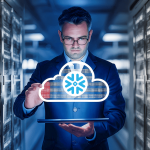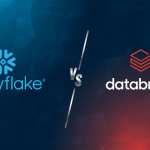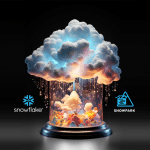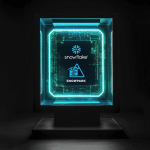Why this blog?
Gain a clear understanding of how Snowflake’s security and compliance features can help your organization meet regulatory requirements and protect sensitive data. You will discover practical applications of key security measures, learn how to leverage dynamic data masking, encryption, and access policies, and understand how Snowflake adheres to industry standards. It equips you with actionable insights to enhance your data security strategy and ensure compliance with ease.
Security and Compliance Features in Snowflake
Snowflake is designed with a comprehensive security framework that ensures data safety, privacy, and compliance with global regulations. As data governance and regulatory concerns grow, particularly for industries handling sensitive data like healthcare and finance, Snowflake provides advanced security features that offer protection across the data lifecycle, from ingestion to querying. Let’s dive into some key security and compliance features Snowflake provides:
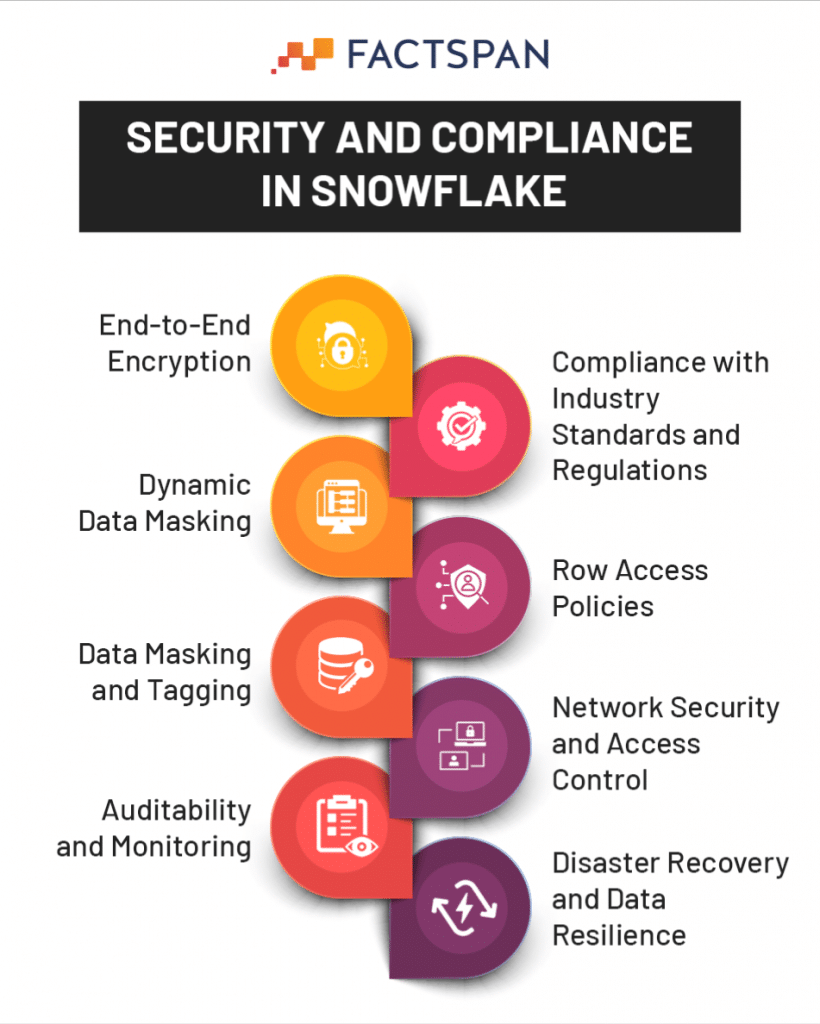
1. End-to-End Encryption
- Data Encryption in Transit and at Rest: Snowflake ensures that all data is encrypted both when it’s being stored (at rest) and during transmission (in transit). It uses AES-256 encryption for data at rest and TLS (Transport Layer Security) for data in transit. This ensures that no unauthorized third party can intercept or tamper with the data at any point in the data pipeline.
- Key Management: Snowflake offers two types of encryption key management:
- Customer-managed keys: Organizations can control their own encryption keys, ensuring they have full authority over who can access data.
- Snowflake-managed keys: Snowflake automatically handles key rotation and management, relieving organizations from operational overhead while ensuring keys are secure and rotated regularly.
- Automatic Key Rotation: Snowflake rotates encryption keys periodically and automatically, ensuring that even if a key were compromised, it would only expose a minimal amount of data, reducing risk.
2. Compliance with Industry Standards and Regulations
Snowflake is compliant with numerous industry-specific regulations and standards, making it a trusted platform for organizations with stringent data privacy and protection requirements.
- GDPR (General Data Protection Regulation): Snowflake is fully compliant with the EU’s GDPR, which requires organizations to protect personal data and privacy of EU citizens. Snowflake’s infrastructure allows organizations to control data residency, ensuring that data remains in the region specified by the user, a critical component for GDPR compliance.
- HIPAA (Health Insurance Portability and Accountability Act): For healthcare organizations, Snowflake meets HIPAA regulations, ensuring that protected health information (PHI) is stored, accessed, and managed securely. Snowflake provides the necessary safeguards, including data encryption and strict access control, to ensure that healthcare data remains secure and compliant.
- CCPA (California Consumer Privacy Act): Snowflake helps businesses comply with the CCPA, which mandates the protection of California residents’ personal information. It provides features that enable organizations to handle requests for data access, deletion, and portability under CCPA regulations.
- SOC 2 Type II: Snowflake is certified under SOC 2 Type II, which verifies that it meets the required standards for handling data securely and protecting against unauthorized access or disclosure. This certification ensures that Snowflake follows stringent procedures to safeguard data.
- FedRAMP (Federal Risk and Authorization Management Program): Snowflake is authorized under FedRAMP, ensuring that it meets the security and compliance requirements for government agencies handling sensitive data in the cloud.
3. Dynamic Data Masking
- Fine-Grained Data Security: Dynamic Data Masking allows organizations to control how much sensitive data users can see based on their roles and permissions. For example, a finance team may need access to full credit card numbers for fraud analysis, but customer support agents may only need to see the last four digits.
- Real-Time Masking: Data masking occurs in real-time, ensuring that sensitive information like personally identifiable information (PII) is protected without affecting performance. Users only see the masked version of the data depending on their access levels, making it highly secure.
- Use Cases: Dynamic data masking is ideal for industries like healthcare (for PHI), finance (for credit card information), and any organization handling sensitive customer or employee data.
4. Row Access Policies
- Granular Control at the Row Level: Row Access Policies give administrators the ability to control access to specific rows in a table based on attributes of the user requesting the data. This means different users or groups can have access to different subsets of the same table without needing separate tables for different levels of access.
- Data Segmentation Based on Roles: This is particularly useful in multi-tenant environments where different business units or external clients may need to see only their own data. By setting up row-level policies, Snowflake ensures that each user or team only sees the relevant data.
- Compliance and Privacy: Row access policies are critical for adhering to privacy regulations, as they ensure that only authorized personnel can view sensitive data, helping organizations to maintain compliance with laws like GDPR and HIPAA.
5. Data Masking and Tagging
- Sensitive Data Tagging: Snowflake allows organizations to tag sensitive data for better visibility and control. Tags can be applied to any part of the data infrastructure, from tables and views to specific columns, enabling better tracking and compliance reporting.
- Automated Data Classification: Once data is tagged, Snowflake can enforce policies that limit access or automatically apply masking based on user roles. This makes compliance with regulations like GDPR and CCPA easier, as organizations can demonstrate that sensitive data is being handled appropriately.
6. Network Security and Access Control
- Private Connectivity: Snowflake provides the option of private connectivity through AWS PrivateLink, Azure Private Link, or Google Cloud Private Service Connect, ensuring that all traffic between Snowflake and other services remains within a private network.
- Role-Based Access Control (RBAC): Snowflake uses role-based access control to manage data access. Administrators can define specific roles with different permissions (read, write, delete) and assign users to these roles, ensuring that only authorized individuals can access certain datasets.
- Multi-Factor Authentication (MFA): Snowflake supports MFA for all users, providing an extra layer of security by requiring users to verify their identity using multiple authentication methods before accessing the platform.
- Single Sign-On (SSO): Snowflake integrates with popular SSO providers (Okta, ADFS, etc.), ensuring that organizations can manage access centrally while reducing the risk of unauthorized logins.
7. Auditability and Monitoring
- Comprehensive Logging and Auditing: Snowflake automatically logs all activities, such as data access and query execution, and provides detailed audit trails. This allows organizations to track and review how data is being accessed and by whom, making it easier to identify and resolve any security or compliance violations.
- Real-Time Monitoring: Snowflake provides real-time monitoring and alerting capabilities, allowing administrators to detect any unusual activity or potential security threats as they occur. This is essential for identifying and mitigating risks before they can lead to data breaches.
8. Disaster Recovery and Data Resilience
- Time Travel and Fail-Safe: Snowflake’s Time Travel feature allows organizations to recover data that has been accidentally modified or deleted, offering a built-in safety net for data resilience. Fail-Safe adds an additional layer of protection by enabling organizations to restore historical data even after Time Travel limits have been exceeded.
Looking to boost your business with better data management?
Talk to our experts to see how Snowflake can simplify your data operations and drive your business growth.

Snowflake’s Commitment to Security
Snowflake offers a robust security and compliance framework designed to protect data across its entire lifecycle. From end-to-end encryption and dynamic data masking to advanced row access policies and auditability, Snowflake ensures that organizations can meet stringent regulatory requirements while safeguarding sensitive information. Its compliance with industry standards like GDPR, HIPAA, and SOC 2 Type II, alongside features like private connectivity and multi-factor authentication, make it a trusted platform for industries such as healthcare, finance, and government.
By leveraging Snowflake’s security features, organizations can confidently handle sensitive data, maintain compliance, and mitigate risks associated with data breaches. With capabilities like real-time monitoring, disaster recovery, and automated data classification, Snowflake delivers a secure, scalable solution for modern data management, enabling businesses to focus on innovation without compromising on data protection.


